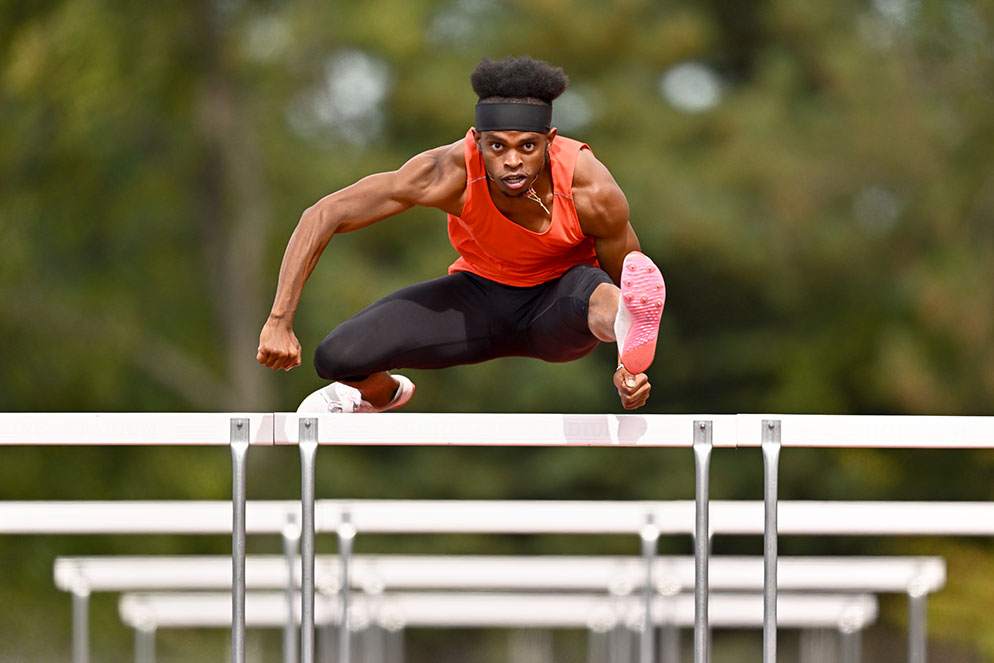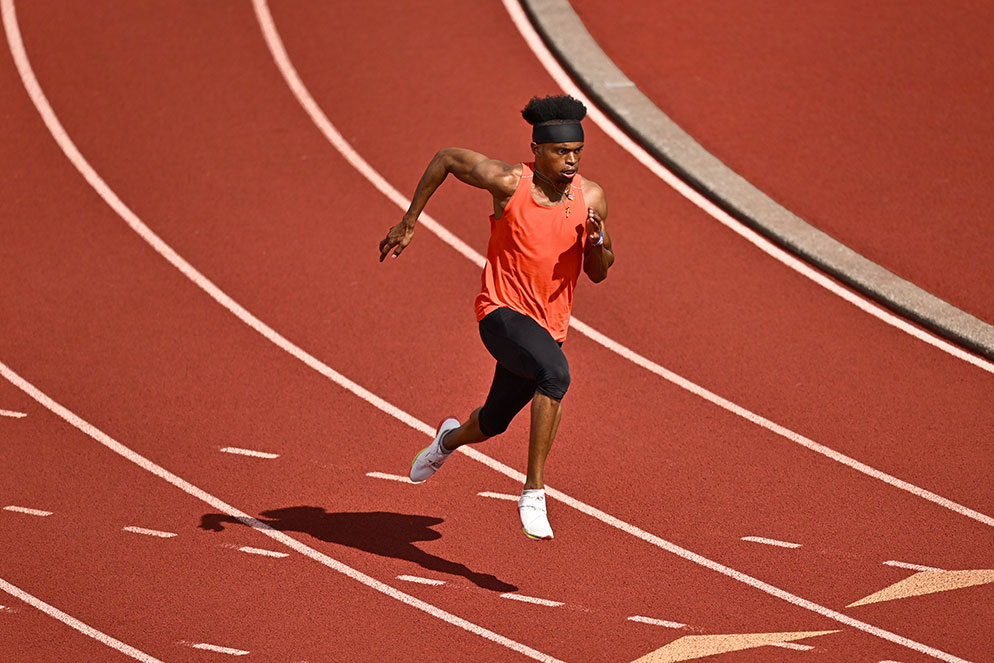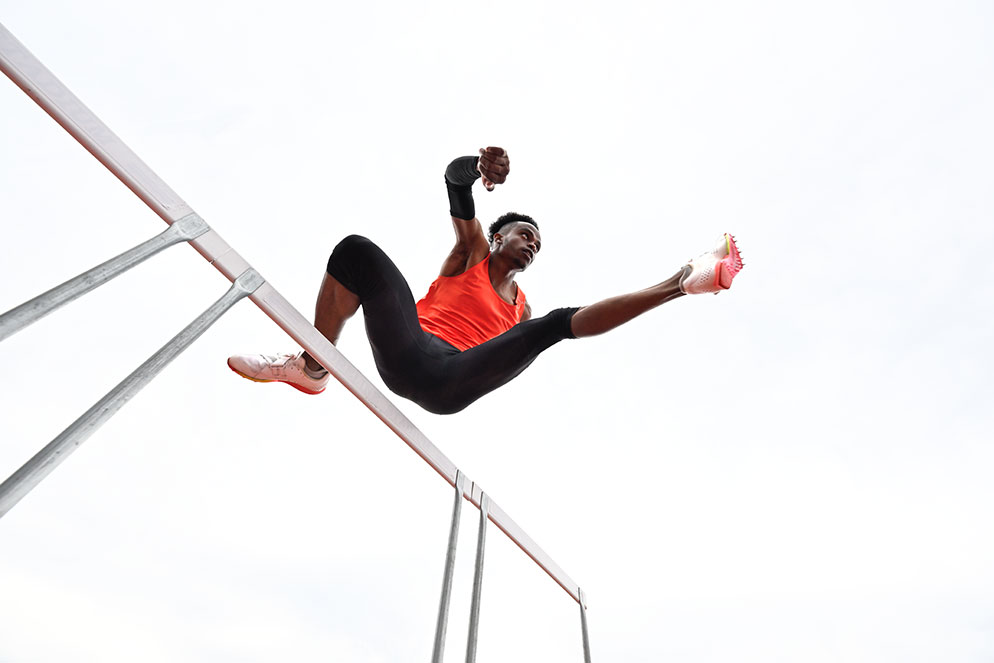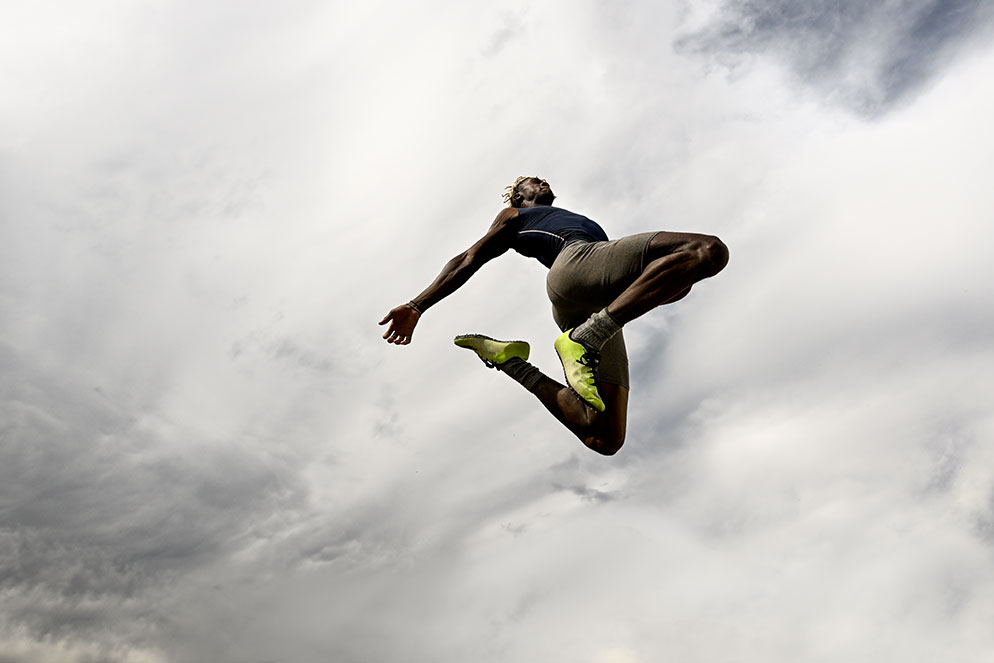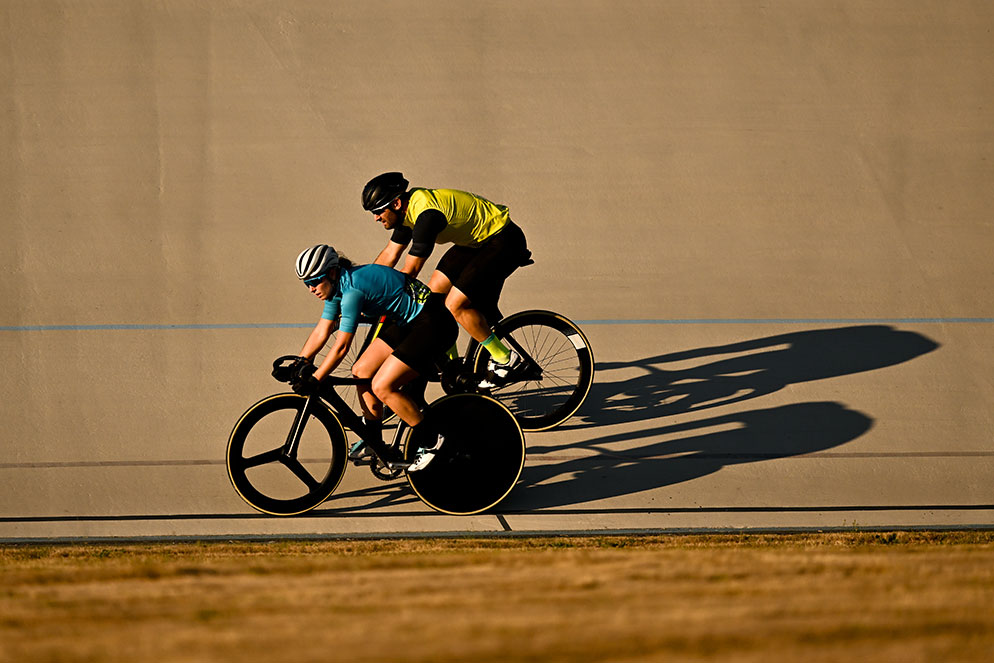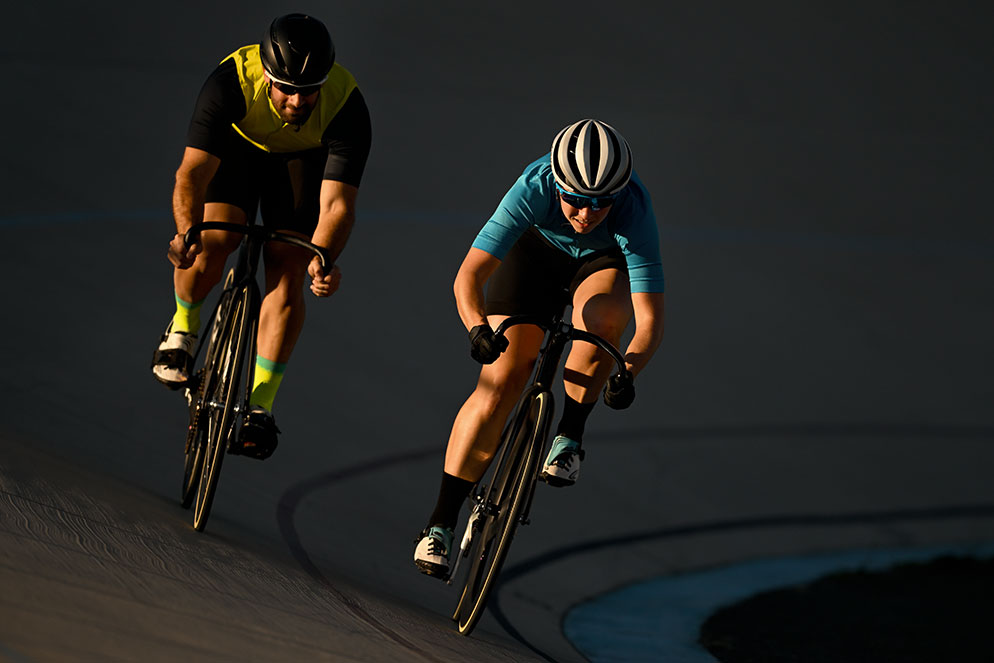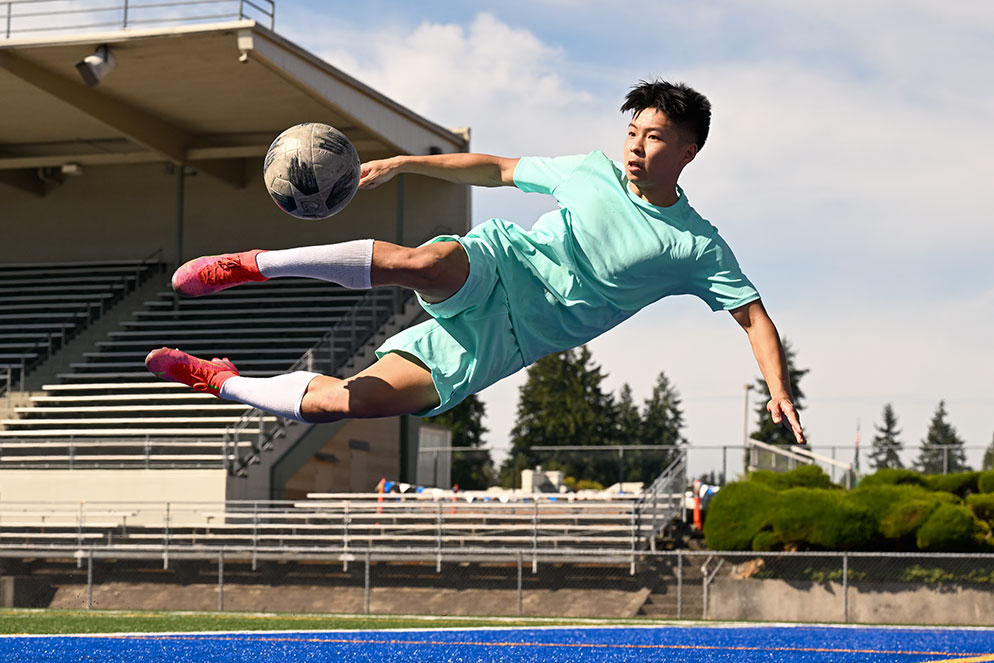Q: How Does the Z 9 Give You the Sports Edge?
A: It’s Ready Before You Are
“A great athlete, doing the high hurdles, and I’m on the track, very low, and it’s three steps, jump, land, three steps, jump, land, again and again, and there were times when, at the background hurdles, I knew I was not going to see his face. Would the Eye AF hold focus on him? It did, and the shoot was filled with ‘Wow, this is an incredible camera’ moments.” Z 9, AF-S NIKKOR 400mm f/2.8E FL ED VR, Mount Adapter FTZ II, 1/10,000 second, f/2.8, ISO 800, manual exposure, Matrix metering.
Sports photographer Rod Mar saw the benefit of mirrorless on day one. He saw the benefit of Z 9 mirrorless at inch one.
What Rod wants to see in the picture is the inch of air between the ball and the fingertips. “The difference between the ball in the receiver’s hands and in the air the moment before it’s caught is everything,” he says. “Can you get that peak moment before the catch, not just after?” That “before” moment was something his most recent DSLRs were always able to get; now, with the Z 9, his mirrorless gets it.
Rod, one of today’s premier sports shooters, is team photographer for the Seattle Seahawks, which explains his ready reference to football in his judgment of the Z 9’s capabilities. He is equally at home in the ballpark, on the links, on the track and at the Olympics, and for him—and we expect countless others—the Z 9 is the all-sports machine.
Rod is also a Nikon Ambassador, and when we spoke with him about the sports edge provided by the Z 9, he paid the camera and its engineers two memorable compliments: “In developing this camera, it seems to me that Nikon engineers took the unrealistic expectations of pro photographers into account, and then made them real.” And, “From now on, no one shooting with the Z 9 is going to be able to blame a blown shot on gear; if it happens, it’s on us.”
“The Z 9’s 20 frames per second gave me the opportunity to capture this moment of speed and athleticism—his arms and legs driving, both feet off the ground,” Rod says. Z 9, AF-S NIKKOR 400mm f/2.8E FL ED VR, Mount Adapter FTZ II, 1/12,800 second, f/2.8, ISO 400, manual exposure, Matrix metering.
Awake at the Switch
As a sports photographer, what Rod wanted most from the Z 9, naturally enough, was what he termed “top-notch AF—the ability to grab focus very quickly.” Then he adds, “And something I think people don’t think about—the need for the camera to react instantaneously.”
“React” as in “be ready when I am.”
Pro shooters at sporting events—basketball, football, hockey, baseball, soccer—have multiple cameras with them; often, they’re wearing them. “You’re shooting with a primary camera,” Rod says, “and it might have a long lens—a 400mm or 600mm for me—and then the action ends up coming towards you, and you grab the camera that’s got the wide-angle lens and you shoot immediately. There’s no time for the camera to wake up—I need it to grab focus and start shooting instantaneously.”
And while in sports photography there’s a lot of talk about frames per second (the Z 9 can do 20, 30 and 120), Rod says, “Here’s the thing: in sports sometimes it’s that first frame, especially when you’re switching lenses from long to short. Things are happening, and that ability to capture an image without any lag in camera startup or the shutter firing, that’s one of the things professional sports photographers demand.”
From now on, no one shooting with the Z 9 is going to be able to blame a blown shot on gear; if it happens, it’s on us.
In this image the Z 9’s vehicle recognition AF tracked the front wheel of the lead cyclist’s bike. “The camera has to recognize the circle in order to track the wheel—which is remarkable.” Z 9, AF-S NIKKOR 400mm f/2.8E FL ED VR, Mount Adapter FTZ II, 1/12,800 second, f/3.2, ISO 400, manual exposure, Matrix metering.
Sizing It Up
One feature of the Z 9 that caught Rod’s attention right away was what he calls “the big deal” of choosing an image size. “If I need to transmit quickly, I can shoot RAW plus JPEG and the camera will give me a JPEG in seconds, and that opens up a lot of opportunities. No one cares if I get the picture and I’m the only one who sees it. If we can’t get it up to the social media platforms within minutes, and then onto Instagram and Twitter, that photo loses a lot of value during a game. And then there’s a lot for later with the RAW file—promotions, posters, archives, news stories, maybe a huge promo mural of a spectacular play.” In that respect, he says “the Z 9 really becomes the Swiss Army knife of cameras, giving me all I need. It’s allowed me to be better at what I do, and I will not hesitate to put it in my bag and replace pretty much everything else I have.”
Rod wanted to see if the Z9’s face and eye detection would track the lead cyclist as she came out of the turn into tricky light and headed toward him. “There are features of this camera that are truly magical,” he says, “and I’m excited to put them in play.” Z 9, AF-S NIKKOR 400mm f/2.8E FL ED VR, Mount Adapter FTZ II,1/10,000 second, f/3.2, ISO 400, manual exposure, Matrix metering.
The Key Word
Once upon a time in sports photography the word was anticipation. Knowing the situational tendencies of a player, a coach, a manager, even a team meant there was a chance to know the likelihood of a particular play. Today, the practically magical abilities of a camera—let’s say the Z 9—might essentially negate the need for anticipating the next move.
Or so we thought. Turned out we had the wrong word.
“I shot this from a low angle because here I wanted the context of the setting, but none of the distractions a straight-on shot might include. And I wanted to stop his motion at a real moment of peak athleticism.” Z 9, NIKKOR Z 24-70mm f/2.8 S, 1/2500 second, f/5.6, ISO 400, manual exposure, Matrix metering.
“For me it’s not a matter of anticipation, it’s a matter of confidence,” Rod says. “Even though I cover a specific team and their practices and I know their tendencies, the thing about football is there are 22 players on the field and people are moving all the time. I don’t know where the ball is going, especially on a pass play where there might be three or four receivers in a pattern and the QB is adjusting his throw depending on where he sees defenders. So yes, I can anticipate based on the situation—I have that knowledge—but what I need is the confidence that I can switch cameras if the receiver is coming right at me and I can raise the 24-70mm lens on the camera around my neck and get that frame.”
Right, that frame—the one where the ball’s still in the air, an inch from the catch.
Rod Mar & Z 9 - When the goal is next-level sports images, the one-for-all is the Z 9.

